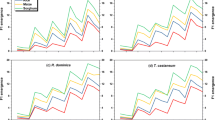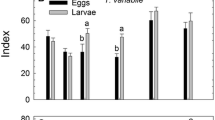Abstract
DDT and BHC were used prior to 1954 as grain protectant but gradually malathion was adopted as prophylactic spray at 50 mg/m2. However, during the continuous usage, doses were enhanced up to 150 mg/m2 to meet the level of effective kill. Toxicity studies on different surfaces, seeds, moisture content level, different insects and stages and emergence of resistance were carried out with respect to malathion and several newer insecticides. DDVP was incorporated in spray schedule at 100 mg/m2. Toxicity data on 17 insecticides, three formulations, persistence on six surfaces and three seeds, tests on 13 insects have been utilized to evolve a strategy for future developments of a prophylactic insecticides. Demerits of switching to new insecticides without broad-based toxicity data have also been advocated. Insects, such as, larva of Trogoderma granarium Everts and adults of Tribolium castaneum (Hbst.), Rhizopertha dominica Fab., Callosobruchus maculatus Fab., Lasioderma serricorne Fab. and Sitophilus oryzae Linn, among beetles and Ephestia cautella (Wlk.) and Corcyra cephalonica Staint from moths were found least susceptible to most of the insecticides. Etrimfos and deltamethrin were adjudged superior for large scale use specially as wettable powder and adjudged suitable to sub-tropical conditions. The paper also provides information on currently used insecticides in India, methods of grain storage at rural and organized level and various constraints faced in the developing countries.
Résumé
Le DDT et le BHC ont été utilisés jusqu’en 1954 afin de protéger les récoltes. Un traitement prophylactique utilisant 50 mg/m2 de malathion les a peu à peu remplacés. Du à l’utilisation permanente de ces traitements les doses ont été élevées à 150 mg/m2 pour obtenir le seuil d’efficacité. Des études sur l’effet toxique du malathion sur différentes surfaces traitées même sur les récoltes, sur différents insectes, leurs stades et l’apparition de résistance contre le malathion et d’autres insecticides nouveaux ont été publiés. Le DDVP a été incorporé dans des programmes d’utilisation par spray (100 mg/m2). Des mesures de la toxicité de 17 insecticides, 3 formulations, la persistence sur 6 surfaces et 3 sortes de grains, des tests sur 13 insectes ont été utilisés pour élaborer une stratégie pour des développements d’insecticides prophylactiques d’avenir. L’utilisation d’insecticides nouveaux peut aussi présenter des désavantages, l’étude de leurs toxicités sur un grand nombre d’espèces est ainsi également recommandée. Des insects tels, les larves de Trogoderma granarium Everts et les adultes de Tribolium castaneum (Hbst.), Rhizopertha dominica Fab., Callosobruchus maculatus Fab., Lasioderma serricorne Fab. et Sitophilus oryzae Linn. parmi les coléoptères et Ephestia cautella (Wlk.) et Corcyra cephalonica Staint parmi les mites se sont montrés moins sensibles à la plupart des insecticides. Etrimphos et deltamethrin se sont montrés supérieurs pour le traitement massif particulièrment sous forme de poudre humide (conditions utilisables dans les régions sub-tropicales.) Cette communication contient aussi des informations concernant les insecticides utilisés aux Indes, sur les méthodes de stockage de récoltes au niveau rural et entreprises organisées, de même sur les différentes contraintes rencontrées dans les pays en voie de développement.
Similar content being viewed by others
References
Bhatia S. K., Yadav T. D. and Mookherjee P. B. (1971) Malathion resistance in red flour beetle, Tribolium cas-taneum (Herbst ). J. stored Prod. Res. 7, 227–230.
Bindra O. S. and Sidhu T. S. (1975) Effectiveness of malathion as a protectant for maize grains. Pesticides (Sept.) 7, 23–26.
Bindra O. S. and Udeaan A. S. (1973) Efficacy of malathion as a protection for wheat grains. Pesticides (Feb.) 11–14.
Girish G. K., Goyal R. K. and Krishnamurthy K. (1971) Efficacy and residual toxicity of iodofenphos and malathion (5% dust) against stored grain pest—II. Pesticides 5, 18–20.
Pingale S. V. and Majumder S. K. (1955) Impregnation of jute bags for the insects free storage of foods—relative efficacy of some insecticides. CF.T.R.I. Bull, 4, 83–86.
Pawar C. S. and Yadav T. D. (1976) Effect of the organic diluents on the toxicity of malathion and baythion against Callosobruchus maculatus (Fab.) and C. chinensis (Linn.). Bull. Grain Techn. 14, 211–218.
Pawar C. S. and Yadav T. D. (1980) Persistence of or-ganophosphorus insecticides on different surfaces. Indian J. Ent. 42, 728–736.
Pawar C. S. and Yadav T. D. (1982) Toxicity of six organophosphorus insecticides against different age groups of Cadra cautella (Wlk.) and Corcyra cephalonica (Staint) Indian J. Ent. 44, 149–157.
Rahman M. and Yadav T. D. (1985a) Efficacy of delta-methrin, cypermethrin, permethrin and fenvalerate dust on three seeds with different moisture content stored in different containers upto 180 days against Callosobruchus maculatus Fab. and C. chinensis Linn. Seeds and Farms 12, 39–50.
Rahman M. and Yadav T. D. (1985b) Persistence of deltamethrin, cypermethrin, permethrin and fenvalerate on different surfaces. Bull. Grain Techn. 23, 103–110.
Rahman M. and Yadav T. D. (1985d) Efficacy of deltamethrin cyper methrin, permethrin and fenvalerate dusts losobruchus maculatus Fab. and C. chinensis Linn. Indian J. Ent. 47 (in press).
Rahman M. and Yadav T. D. (1985d) Efficacy of deltamethrin cyper methrin, permethrin and fenvalerate dusts against developmental stages of Callosobruchus maculatus Fab. and C. chinensis Linn. Indian J. Ent. 47 (in press).
Singh S., Jha A. N. and Yadav T. D. (1983) Toxicity of dusts of DDT and lindane against beetle pests of stored seeds. Seed Res. 11, 91–94.
Yadav T. D. (1973) Studies on the insecticidal treatments against bruchids, Callosobruchus maculatus (Fab.) and C. chinensis (Linn.) damaging stored leguminous seeds. Ph.D. thesis. Agra University.
Yadav T. D. (1979) Fate of malathion residue on seven pulse seeds. Indian J. Em. 41, 126–133.
Yadav T. D. (1980) Toxicity of DDT and lindane against thirteen species of stored product insects. Indian J. Ent. 42, 671–674.
Yadav T. D. (1985) Toxicity of deltamethrin, cypermethrin and permethrin against thirteen stored product insects. Indian J. Ent. 47 (in press).
Yadav T. D. (1986) Toxicity of baythion and etrimfos against thirteen stored product insects. Indian J. Ent. 48 (in press).
Yadav T. D. and Jha A. N. (1985) Persistence of deltamethrin, cypermethrin and permethrin on storage surfaces. Pesticides 7, 28–30.
Yadav T. D. and Kailasa Nathan K. (1977) Suitability of climate and ecological zones in grain and seed storage in India. Seeds & Farms 3, 29–31.
Yadav T. D., Pawar C. S., Khanna S. C and Singh S. (1980) Toxicity of organophosphorus insecticides against stored product beetles. Indian J. Ent. 42, 28–33.
Yadav T. D., Singh S., Khanna S. C and Pawar C. S. (1982) Toxicity of dusts of organophosphorus insecticides against stored product beetles. Indian J. Ent. 46, 35–40.
Yadav T. D., Singh S., Khanna S. C and Mookherjee P. B. (1979) Efficacy of grain protectants against larval stages of moth pests. Indian J. Plant. Prot. 7, 15–18.
Author information
Authors and Affiliations
Rights and permissions
About this article
Cite this article
Yadav, T.D. Current Status of Conventional Insecticides in Stored Product insect Management in India. Int J Trop Insect Sci 8, 703–707 (1987). https://doi.org/10.1017/S1742758400022803
Received:
Published:
Issue Date:
DOI: https://doi.org/10.1017/S1742758400022803
Key Words
- Prophylactic
- impregnated dust
- stack
- phytotoxic
- residue
- toxicity
- biological efficacy
- dust
- emulsion
- seed treatment
- wettable powder
- bioefficacy
- ecological zone
- persistence
- insecticidal specificity
- tolerant
- susceptible
- sub-lethal dose
- LC50
- toxicity ratio
- internal larva
- external larva
- efficaceous
- socio-economic
- insect pest complex
- traditional
- pest management
- package of practices
- resistance
- cost benefit ratio




